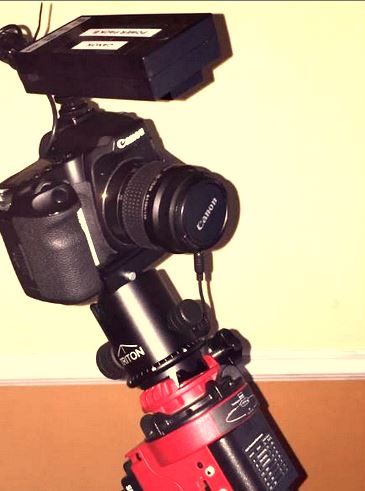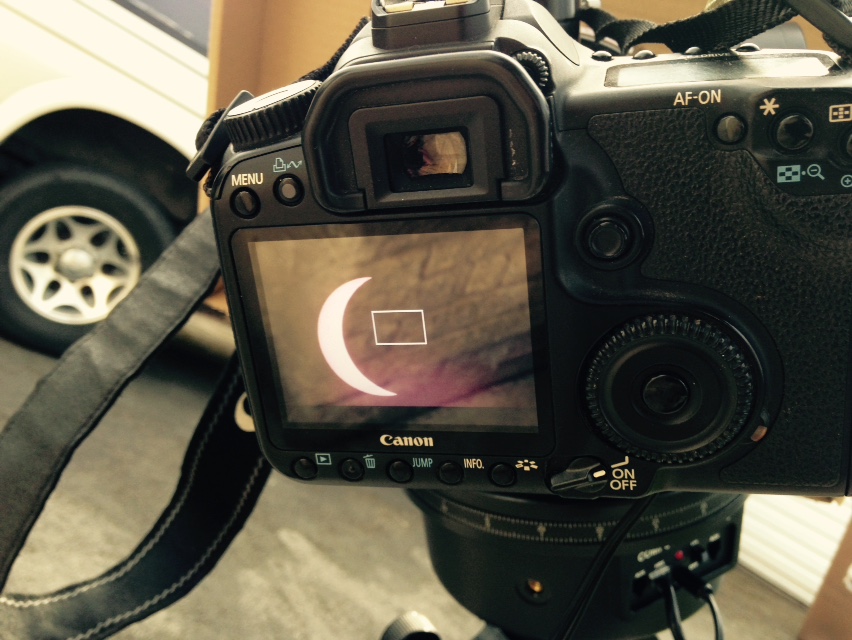Globular Cluster M79 using iPhone to connect to Siding Spring telescope
 Monday, January 18, 2016 at 5:15PM
Monday, January 18, 2016 at 5:15PM 
 [Your Name Here] | Comments Off |
[Your Name Here] | Comments Off |
Ford's excellent
monthly calendar
ABOUT THE WEBSITE - CLICK HERE
My Telescopes
My Main Telescope - C14 and Paramount ME

My new Paramount MyT and 8-inch Ritchey-Chretien Telescope

MyT Hand Controller
My Meade 12 inch SCT on a CGEM (Classic) Mount
My 4 inch Meade Refractor with Sky Watcher Guidescope and ZWO camera on a CGEM (Classic) Mount

Skywatcher Star Adventurer Mount with Canon 40D
My Solar setup using a DSLR and Mylar Filter on my ETX90

DSLR attached to ETX90. LiveView image of 2015 partial eclipse on Canon 40D
I try to log my observing and related activities in a regular blog - sometimes there will be a delay but I usually catch up. An index of all my blogs is on the main menu at the top of the page with daily, weekly or monthly views. My Twitter feed is below. I am also interested in photograping wildlife when I can and there is a menu option above to look at some of my images. I try to keep the news feeds from relevant astronomical sources up to date and you will need to scroll down to find these.
The Celestron 14 is mounted on a Paramount ME that I have been using for about 10 years now - you can see that it is mounted on a tripod so is a portable set up. I still manage to transport it on my own and set it all up even though I have just turned 70! It will run for hours centering galaxies in the 12 minute field even when tripod mounted.
 Monday, January 18, 2016 at 5:15PM
Monday, January 18, 2016 at 5:15PM 
 Tuesday, January 12, 2016 at 7:51AM
Tuesday, January 12, 2016 at 7:51AM  Measured Position R.A. 23h 52m 46s Declination: +17° 21' 58"
Measured Position R.A. 23h 52m 46s Declination: +17° 21' 58"

 Sunday, January 10, 2016 at 11:25PM
Sunday, January 10, 2016 at 11:25PM A 3 minute exposure using Skywatcher Star Adventurer mount with Canon 40D and 38mm lens setting.

 Sunday, January 10, 2016 at 11:23PM
Sunday, January 10, 2016 at 11:23PM Taken earlier tonight - 30 second exposure - Canon 40D with Light Pollution Filter 38mm lens. Skywatcher Star Adventurer mount.
 Saturday, January 9, 2016 at 7:23PM
Saturday, January 9, 2016 at 7:23PM I took another image of NGC 2818 in monochrome with a larger telescope

The above image is a rotated enlargement from the full image below

 Saturday, January 9, 2016 at 5:09PM
Saturday, January 9, 2016 at 5:09PM I used the 90mm refractor at Siding Spring to take an image of NGC 2818. These are the settings just prior to the image being taken. Although I took this on the 9th Jan 2016 the settings show the 10th Jan because Australia has moved into the next day.
This is the resulting image

This is the un-annotated image

 Saturday, January 9, 2016 at 4:02PM
Saturday, January 9, 2016 at 4:02PM 


 Thursday, January 7, 2016 at 10:21AM
Thursday, January 7, 2016 at 10:21AM Before aligning the mount via Polaris at night it is essential to make sure that the axis of the polarscope is parallel to the polar axis itself. If it is not the cross at the centre of the polarscope reticle will perform a little (or large if it is really off) circle of its own as the polar axis is rotated. Aligning via Polaris will then be incorrect and you will get trailed stars. This is a daytime activity. I used a nearby tv aerial on a chimney to do this. I followed "astronomy shed's" guidance and replaced the grub screws on the star adventurer polarscope with thumb screws. This improved the ease of adjustment by about a million times - a huge difference - it is quite painful trying to adjust the reticle position with an Allen Key! I found that Meade thumb screws from some of my other equipment were a perfect fit. I believe it is an M3 thread if you do not have any of these. I will need to buy replacements anyway. I took out the grub screws one at a time and screwed in the thumb screw making sure each was screwed in firmly. The reticle will become loose and even fall out if you take all the grub screws out in one go. If you unscrew the eyepiece you can see how the reticle is held by these three screws. WARNING - if you do this make sure that you do not get any of the copious grease from the eyepiece thread onto the reticle! I found one long thumb screw and two short - this was actually advantageous in that it made it easier to identify which screw is which during the delicate adjustment process. On my polarscope I found that the reticle was rotated clockwise by about 45 degrees from having the 6 o clock position at the bottom. I had to unscrew all of the thumbscrews and used a Q-tip to rotate the reticle anticlockwise by 45 degrees to get the 6 into position at the bottom. When spare plastic thumbscrews arrived via EBay I replaced all three and show the way they hold the reticle in place and allow adjustment below.



[ADDENDUM - I found a better solution to polar scope illumination - £1 from E Bay including the battery! A bit of Velcro secured it and I attached the keyring part to the dovetail bolt. You can't vary the intensity but it will do the job.]
I then went through the daytime alignment process to align the reticle with the polar axis of the mount. I used the astronomy shed process that you can find on a video there using the length of the TV aerial to match up with the lines on the reticle. Note that if you replace the Allen bolts with thumbscrews you will not be able to fit the protective cover. I suspect I would have lost this cover outside in the dark anyway!
I also used the AS technique to test alignment by positioning the end of the TV aerial on the outer reticle circle and rotating the polar axis so that the tip of the aerial draws out the circle as you go through 360 degrees.
